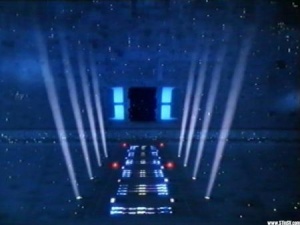StarBase 118 Drydock
| StarBase 118 Ops | ||
|---|---|---|
 ACTIVE STATUS | ||
| ||
The drydock is the massive area inside the base. Due to the high amounts of traffic, most of the ship bays are usually occupied by visiting StarFleet and commercial ships.
Though some spacedock installations also do a high amount of starship refurbishing (usually up to three refits occuring at one time), SB118's important tactical location and high volume of traffic keeps this duty to a minimum. The Downwater Fleet Yards, 30 light years away, does most of the starship construction for the surrounding sectors, freeing up StarBase 118 to act as a commercial and tactical vantage point.
Docking Procedures
Docking a StarFleet vessel at a StarBase such as 118 is a well-established, by-the-book procedure. This manuever is overseen by the StarBase's Flight Control (FLY-CON) and can be automated once the captain of the incoming vessel hands control over to the docking commander.
Two areas control the docking procedure. In the main Command Center, the head Flight Control officer oversees all docking operations, and ensures that there is no danger to the StarBase as a whole. Another location, called the Approach Control Center (ACC), devoted specifically to the actual docking procedure, is located in the docking bay itself. The ACC is staffed by both StarFleet and civilian personnel who are highly trained docking crews that work on a round-the-clock schedule. This location is filled with visual display monitors, which give the most up-to-date status on spacedock activity. Large windows look out onto the docking bays, making certain that visual contact is maintained at all times; this is especially helpful during the docking procedure.
There are often more than a dozen vessels docked in the bay at any one time, and it is therefore extremely important for the docking crew to make sure that an incoming starship has a wide and clear berth at which to dock. Approach Control must also make sure that the numerous shuttle-pods and workpods in the general vicinity remain at a safe distance; clear channels of communication in the command center have to be maintained during these delicate manuevers.
Flight Control in the main Command Center is responsible for giving all clearances to the spacedoors. In case a starship doesn't follow the correct procedure, either Approach Control or Flight Control can issue a yellow alert to the entire spacedock. Usually, only Flight Control has command over the opening and closing of the space doors, but it has been possible to over-ride this command from aboard a starship.
Docking
Starships begin their approach to spacedock from beneath the level of the space doors using a guideway of lighted beacons. This procedure allows for clearance of any other vessels and ensures that starships are queued in the correct manner. If more than one starships is waiting entry into the spacedock, they remain within the lighted guideway (which extends for a number of kilometers away from the base) following the lead starship with at least 3 kilometers between each ship. Once a starship enters the lighted guideway, Fleet Operations hands jurisdiction of the starship over to Flight Control.
Once a starship is in the correct position, facing the space doors, the final approach procedure is initated by the communications officer on the incoming starship. Upon the command of the captain, the com officer will tell Approach Control that the vessel is ready for docking. The starship then receives confirmation that it is cleared to dock, and the captain will request a lock-on command; this will be confirmed by the starship's helm, who will say, "Systems locked."
Once the proper acknowledgements have been made, the space doors will open (if closed during approach) and the starship commences the final automated docking procedure, traveling over a directional array of evenly spaced lights toward its assigned bay. The starship slowly enters the docking bay using its aft thrusters only. Each starship is assigned a docking port which is set back from the docking bay in what could be compared to a "parking space." Each docking port is numbered, e.g.- Port 4. (Alternatively, they are sometimes called "Airlocks".) Assuming that there are no other starships waiting to enter the bay, the space doors will be closed immediately.
As the starship enters its assigned bay, the captain will call for standby umbilical and gravitational support systems. There may be other systems required, depending upon the class of the starship. For instance, Galaxy class ships engage mooring beams and lock them off during docking procedures. All of these systems are critical to the safety of the starship while it is in the bay, and the vessel must be secured properly at all times. The captain's call for these systems is again acknowledged by the starship's helm officer. At this point, the helm officer can complete the rest of the docking procedure with or without the captain's interaction.
The only formality that remains is for the incoming starship's commanding officer to request permission to come aboard. This usually happens at the airlock doors which connect the starship and spacedock through a long enclosed gangway (also called "Airlock"). Once the captain receives permission, the docking procedure is complete, and all necessary repairs and other orders of the day can be carried out. Much pedestrian activity will take place as crew members exit the vessel via gangways. StarFleet protocol requires at least one officer to be posted on the spacedock-end of the gangways at all times, to monitor and log all activity on and off the starship.
The departure of the starship from spacedock is effectively the same procedure in reverse. Depending upon the confining space within the docking bay, a starship can either back out the space doors, or go forward. The starship cannot initate warp drive or impulse engines until safely outside the immediate vicinity of the base.


